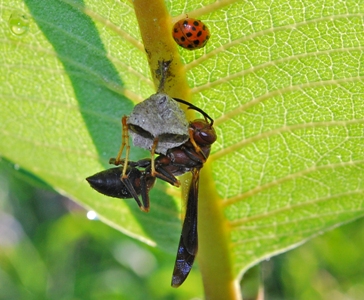 Wood ducklings (Aix sponsa) float among water lilies (Nymphaea tuberosa)
Wood ducklings (Aix sponsa) float among water lilies (Nymphaea tuberosa)Numerous ponds are scattered throughout the grounds of Shaw Nature Reserve, the most prominent of them being Pinetum Lake near the main entrance. Numerous shallow ponds occur near the Wetland Trail and Brush Creek Trail. Most are unnamed, but are indicated on the Shaw Nature Reserve map. These are among the more interesting ponds, because they were seeded with diverse wetland plants shortly after construction, and the lack of fish in most of them allows a much greater diversity of insects and amphibians to occupy them, relative to the older, fish-inhabited ponds.
 Shaw Nature Reserve also has four older and deeper ponds. Wolf Run Lake, the largest of the four, is a tranquil resting place near the end point of Wolf Run Trail. Second-growth forest, once cut-over for farming, frame the lake and are mirrored in the water. Broad-leaved cattail grows in areas around the pond, a factor in natural pond succession. Animals and birds are attracted to the lakeside. The water abounds with frogs, turtles, fish, snakes and insects. Pot-Hole Lake, located near the north and lower boundary of the Tallgrass Prairie, enhances the view from the prairie hilltop and is an interesting community of itself. Fish and pond life can be observed; a variety of vertebrate and invertebrate animal life is also attracted to the water.
Shaw Nature Reserve also has four older and deeper ponds. Wolf Run Lake, the largest of the four, is a tranquil resting place near the end point of Wolf Run Trail. Second-growth forest, once cut-over for farming, frame the lake and are mirrored in the water. Broad-leaved cattail grows in areas around the pond, a factor in natural pond succession. Animals and birds are attracted to the lakeside. The water abounds with frogs, turtles, fish, snakes and insects. Pot-Hole Lake, located near the north and lower boundary of the Tallgrass Prairie, enhances the view from the prairie hilltop and is an interesting community of itself. Fish and pond life can be observed; a variety of vertebrate and invertebrate animal life is also attracted to the water.
Mirror Lake is a small, round pond, set in the rolling meadows, north and east of the Trail House. This pond lies over a sinkhole—a collapsed cavern—and some day may be swallowed up by further geologic processes below.
Few visitors see Wood Duck Lake but it is a small, secluded pond of great charm, tucked away near the East Bridge. Bald cypress trees grow on a small island and many species of birds find the area attractive.
More about ponds at Shaw Nature Reserve